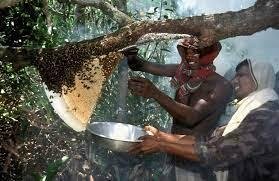
Sundarbans is surrounded by diverse natural beauty. Three rivers, the Ganges, Brahmaputra and
Meghna, come together to form the Sundarbans - the largest delta in the world. It is a complex
network of islands linked by rivers and creeks. Sundarban is scattered across the western area
of Bangladesh and the state of West Bengal in eastern India. In the part of West Bengal, there
are 13 blocks in South 24 Parganas district and 8 in North 24 Parganas district. The Sundarban
Honey is available in 115 compartments in the core area.
The Sundarban Honey
Other than mangroves, Royal Bengal Tigers & crocodiles, Sundarban is world-famous for its
honey. Sundarban homes two varieties of natural honey in her bio-diversity. The most famous
of these is the white-colour honey obtained from the khalisha flower, which can be found deep
inside the forest. The other one is slightly yellowish, obtained from kewra flowers.
The Moulies and Their Unsure Livelihood
The honey hunters of the dense Sundarbans are called Moulies. Every spring, they go out to
collect valuable honey, taking risks in their own lives. Collecting wild honey is the only way for
them to earn a living. They always travel together in the forest to find beehives. They always
carry primitive weapons such as axes, tangis, bows arrows. Before going to the forest, they
stock up on basic rations for more than a month. Under the leadership of experienced moulies,
they set off for the deep forests of Sajanekhali, Sudhanyakhali, DoBanki and other core areas.
Before the voyage, they offer prayers to Banabibi, the goddess of the Sundarban forest. The
whole village and family members gather to see their husband, son, brother and friends. No
one knows who among their family, relatives or friends will return safely and who will be lost
in the forest forever. Until the honey hunters, fishermen and carpenters return home, the women
of those families come to Banabibi Than; (their place of worship) every day. In there, they light
candles every evening and pray for the safe return of
their loved people. During those days, the housewives and villagers go through several rituals.
After all these, moulies set sail in small boats and anchors in a suitable area of deep mangrove
forest. In deep forests, they usually anchor boats close to each other for safety reasons. The
reason for their safety is not just the Royal Bengal Tiger, but also poachers, smugglers; pirates.
They patrol the forest by boat and hide in the creek. They travel by water along the border
between India and Bangladesh in the Sundarbans.
After landing at a core area, they worship Banabibi again. Some of them team up through the
dense forest, beating drums and moving in a single line with illuminated torches - looking for
beehives. The rest of the people stay in the boat to guard. To fool tigers, they often wear a
tiger-printed mask on the back of their head - although it doesn't work most of the time.
Despite the warnings, often they find that someone from the middle of the group is gone
missing. All this happens because of a silent tiger attack. In the same way, the guards on boats
fall prey to tigers in this way or die every year after being shot by poachers & smugglers.
All these families solely depend on the Sundarbans forest. Keeping life a risk, they are allowed
to collect the famous delicious honey of the Sundarbans only once a year. In April & for 14 days,
the moulies can enter the forest with permission from forest authorities. Till the moulies return
from the deep jungle, the family members eagerly wait for them. As soon as the moulies return
home, the starts festival with the beating of drums. They go inside the house or into the light
forest and worship the goddess Banabibi.
The Welfare of Moulies
We have already told you earlier that Sundarban honey is world-famous for its taste & smell.
Every year, moulies collect approx 15 to 16 thousand metric tonnes of raw honey from
Sundarban. The quantity is more than half of the honey extracted from all over the country.
Each year, governments earn a large amount of money through the domestic sales and export
of this honey. But in return, the government doesn’t do that much for them. There is no end to
the allegations of the moulies against the government. Various natural disasters hit the
Sundarbans every year. In past years, during cataclysms or cyclones, Sundarban has witnessed
several damages and death of people. Although some NGOs do some social work every year, it
is very inadequate. Until the government does something for their welfare, moulies will remain
helpless; so the Sundarban honey industry.

Add new comment